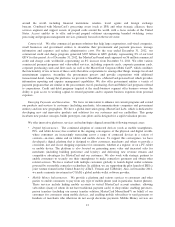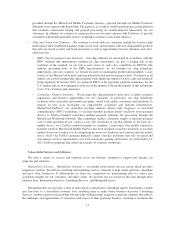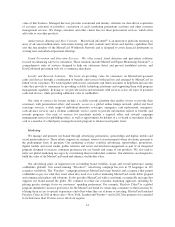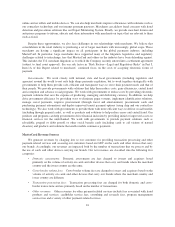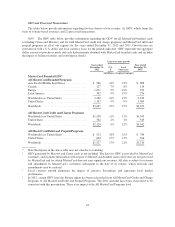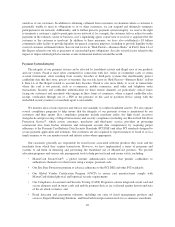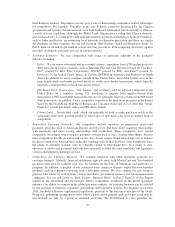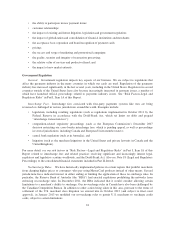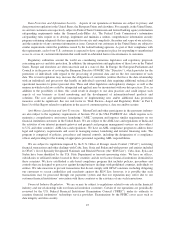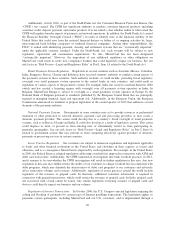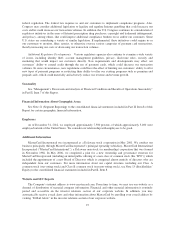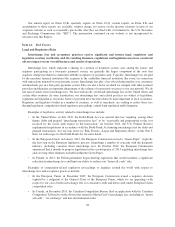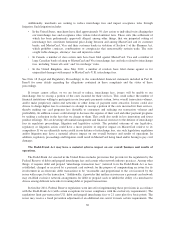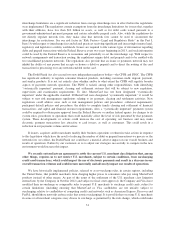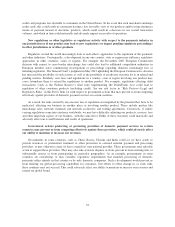MasterCard 2012 Annual Report Download - page 26
Download and view the complete annual report
Please find page 26 of the 2012 MasterCard annual report below. You can navigate through the pages in the report by either clicking on the pages listed below, or by using the keyword search tool below to find specific information within the annual report.their domestic markets. Regulation can also play a role in determining competitive market advantages
for competitors. For example, UnionPay is the sole domestic processor designated by the Chinese
government and operates the sole national cross-bank bankcard information switch network in China as
a result of local regulation (although the World Trade Organization’s ruling that China’s domestic
processing industry is a monopoly could open the domestic payments marketplace). Some governments,
such as India and Russia, are promoting local networks for domestic processing and there are similar
developments in other countries. See our risk factor in “Risk Factors—Legal and Regulatory Risks” in
Part I, Item 1A related to government actions that may prevent us from competing effectively against
providers of domestic payments services in certain countries.
•Particular Segments. We face competition with respect to particular segments of the payments
industry, including:
ODebit. We encounter substantial and increasingly intense competition from ATM and point-of-sale
debit networks in various countries, such as Interlink, Plus and Visa Electron (owned by Visa Inc.),
Star®(owned by First Data Corporation), NYCE®(owned by FIS), and Pulse®(owned by
Discover), in the United States; Interac in Canada; EFTPOS in Australia; and Bankserv in South
Africa. In addition, in many countries outside of the United States, local debit brands serve as the
main brands while our brands are used mostly to enable cross-border transactions, which typically
represent a small portion of overall transaction volume.
OPIN-Based Debit Transactions. Our business and revenues could be adversely impacted in the
United States by a tendency among U.S. merchants to migrate from signature-based debit
transactions to PIN-based debit transactions because we generally earn less revenue from PIN-based
debit transactions. In addition, Visa’s competitive response to the limitations presented in the United
States by the Dodd-Frank Wall Street Reform and Consumer Protection Act of 2010 (the “Dodd-
Frank Act”) could potentially reduce our PIN debit volumes.
OPrivate-Label. Private-label cards, which can generally be used to make purchases solely at the
sponsoring retail store, gasoline retailer or other types of merchants, also serve as another form of
competition.
•End-to-End Payments Networks. Our competitors include operators of proprietary end-to-end
payments networks, such as American Express and Discover, that have direct acquiring relationships
with merchants and direct issuing relationships with cardholders. These competitors have certain
competitive advantages over four-party payments systems such as ours. Among other things, because
these competitors provide an end-to-end service, they do not require formal interchange fees to balance
payment system costs between the issuing and acquiring sides of their business, even though they have
the ability to internally transfer costs in a manner similar to interchange fees. As a result, to date,
operators of end-to-end payments networks have generally avoided the same regulatory and legislative
scrutiny and litigation challenges we face.
•Competition for Customer Business. We compete intensely with other payments networks for
customer business. Globally, financial institutions typically issue both MasterCard and Visa-branded
payment cards, and we compete with Visa for business on the basis of individual card portfolios or
programs. In addition, a number of our customers issue American Express and/or Discover-branded
payment cards in a manner consistent with a four-party system. We also compete for new business
partners with whom we seek to work, such as merchants, government agencies and telecommunication
companies. See our risk factor in “Risk Factors—Business Risks” in Part I, Item 1A of this Report
related to the substantial and increasingly intense competition worldwide in the global payments
industry. Our ability to compete in the global payments industry for customer business can be affected
by the outcome of litigation, regulatory proceedings and legislative activity. For example, in October
2011, the Federal Reserve implemented regulations, pursuant to the enactment into law of the Dodd-
Frank Act, prohibiting arrangements under which a debit card or prepaid card can be processed only by
one network (or only by a group of affiliated networks). The Dodd-Frank Act also prohibits any
22


